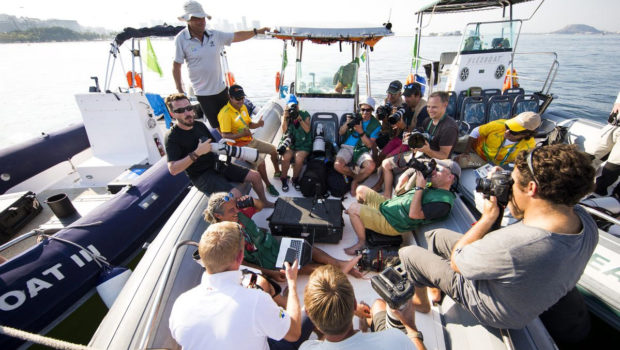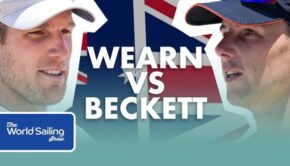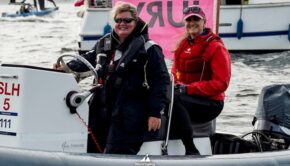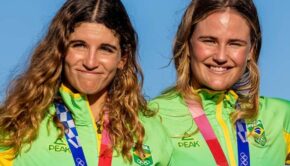Behind the Lens at the Rio Games
Published on September 14th, 2016
At the Rio 2016 Olympic and Paralympic Sailing Competitions, World Sailing’s appointed photographers have been covering all of the classes and every competitor from all angles in an ever changing field of play.
Pedro Martinez and Jesus Renedo worked in tandem at the Olympic Games before Richard Langdon picked up the baton at the Paralympic Games.
The trio are three of the most experienced sailing photographers around, renowned for excellence and professionalism. Their imagery goes far and wide and in the years after Rio 2016 has concluded, the imagery will continue to be used to recall one of the most memorable competitions of all time.
View their galleries here: Olympic Games – Paralympic Games
World Sailing’s Daniel Smith spent some time getting to know the trio in an interview setting to find out about the team behind the lens.
What do you enjoy about photographing sailing?
Pedro Martinez: “When photographing sailing, you are in incredible scenarios with nature in your photo studio. As you increase your experience, you are able to take advantage of every weather condition. I love it when it rains, when it’s dark, when it’s windy, when it weaves and when it’s not. I love when there is a rainbow, when there are birds, jumping fishes or dolphins.
“I love the fact you can’t chose the conditions you work in but you learn how to take advantage.”
Richard Langdon: “I do love photographing smaller boats because it’s more about the people and less about the boat. The boats are attractive as well but it’s all about the dynamics of moving around the boat, even on lightish days there can always be spray which proportionally is quite big compared to the person. There’s a lot more movement and variety. If you’re shooting a Maxi going downwind in 20-knots, there can barely be a ripple. Even going upwind in 15-20 knots, it has to have monstrous seas to get the same dynamics you do with a little boat. I love doing small boats, it’s so varied.”
Jesus Renedo: “I love sailing, and this gives me an opportunity to see the best sailors and boats with a front row seat. And also it helps to get to know them personally. Sometimes it is history in the making, and we are part of it with our images.”
What does it take to shoot in the Olympic and Paralympic arena and what skills are required?
PM: “To me, Olympic sailing is the athletic version of sailing. Sailors move their bodies all the time while they are sailing. They are so close to the water, struggling. They can go crazy when they’re winning or cry when losing. As a photographer, you have to be able to catch that.
“Olympic and Paralympic class regattas have multiple disciplines across different race courses. You have to understand the race courses, recognise the type of boat from a distance and know the top sailors.
“Also, it’s worth having cordiality and adaptability. You have to share a rib with other photographers with different opinions and needs so you need to find a way to achieve your objectives and at the same time, help others achieve theirs.”
RL: “You definitely need knowledge of the course. You need to know where to be to get the right shot. You can get a shot wherever you are on the course, but if you have a preconceived idea of what you want, you have to be in the right spot.
“The other tool, is to have a good driver. He is almost taking the shot for you.”
JR: “A good understanding of Olympic and Paralympic race courses, and the rules of sailing, so that you are aware of what’s happening and what’s going to happen next in the water.
“You need to be in good physical condition to spend many hours at sea, it can be hot, cold, wet and always long. You then need to work fast, both in the water and at the media office.”
What’s the most memorable moment in your career so far?
PM: “Covering the Olympic Games for World Sailing has been the most important job I have ever done. On 11 August I was covering races outside Guanabara Bay with big wind and waves. It was exhilarating. I took one action shot of the French 470 team, Camille Lecointre and Helene Defrance and it is one of my favourite images ever.”
RL: “In terms of my career, probably fishing out five people in the water at the Fastnet Rock who were lost at sea. Rambler 100 had lost its keel and 16 people managed to scramble on top of the upturned hull and the lifeboat went to them. There were no other people in the area, five people were missing and it was getting dark so we went into a search pattern.
“It was petrifying. We saw debris after looking for an hour and a half. They’d been in the water for two and half hours and the debris was getting more and more and we were on the right path. We eventually found all five, including the owner and his girlfriend. They were all huddled together, really struggling.
“We pulled them aboard immediately and got them safely back to shore. That was a really memorable moment, beyond the lens.”
JR: “I can’t choose one. The Vendee Globe start was amazing, and the whole Olympic Games, with the Nacra 17 prize giving being a very special one.”
What’s been the most hair-raising moment?
PM: “I get really excited every time we have big wind and waves. I remember being an event photographer once with conditions just like that. One of the photographers I was sharing a rib with was pushing the driver to not follow the fleet. I was really angry and didn’t want to be with that photographer again.
“As sailing photographers, we prepare and wait for days like that. All the equipment, clothing and experience we have makes it special on days like that. Then if a driver or passenger joins and isn’t prepared it can be really frustrating.”
RL: “I nearly sank on a press boat in Fort Lauderdale back in 1998. I’ve been hit by a Farr 40 in light winds when I was in the water with my camera housing. A windsurfer landed on me once as well and I was out for a split second and concussed. These things happen.”
JR: “The most incredible race was the Audi MedCup in 2009 in Cartagena, 25+ and huge waves. Also I remember our rib almost sunk at the first day of the China Cup in 2010 in Shenzhen, that was scary. And of course the wind blast at the Rio Olympics, outside the bay, late afternoon, 40 knots and more, that was crazy.”
How did you get involved in sailing photography?
PM: “My father has been a sailing photographer for years. I started helping him with photo editing when I was a teenager. I also helped him during the 2007 America’s Cup in Valencia for Desafio Español.
“My dad is the best teacher I ever had. He didn’t explain anything about photography to me.
“He just gave me a camera and asked me to take some photos. The first ones on the dock were pretty good. But then on the water, it was terrible. All the photos were out of focus and I got sea sick.”
JR: “First I was a sailor in the Optimist and dinghies, then an amateur photographer, then a professional skipper, and one day someone asked me to take photos of a local regatta and I realised how much I loved it, and decided to give it a try.”
RL: “My parents always sailed, I’d always sailed and liked taking pictures when I was younger. I studied photography at the arts institute in Bournemouth and I never thought I’d do sailing photography but in the last summer before I was leaving, I covered a few sailing events for fun and I got some pictures published in the Telegraph and other magazines and thought this is easy. That was over 25 years ago and now I’m still doing it.”
What’s it like working for World Sailing, covering every sailor?
PM: “When you are the photographer of World Sailing, especially when you do so at the Olympic Games, then you no longer work for them, you work for the whole world.
“The concept changes so much from other regattas. It’s a big responsibility to deliver images to the world and you have to be critical and exigent with your work as you’re representing the sport first hand.”
RL: “Most Olympic and Paralympic events I work for the British and Dutch sailing teams. I’ve always wanted to work and cover all of the classes though. It’s absolute bliss. I’m loyal to my clients when I’m on the water and only take photographs of them as they’re paying me to cover them.
“Now, if I see an amazing shot I don’t have to think, oh I wish it was the British or Dutch team sailing in front of the Sugarloaf with the fluffy clouds, I can just shoot it and it’s one everyone gains from.”
JR: “I see it like a big family, lots of friends, like fellow photographers and journalists, Race Officials and the jury, the WS staff, and then the sailors. We all work together to make it possible and to finish the cycle every four years with success.”
What’s in the kit bag?
PM: I use three cameras, Canon 1DX with a 600mm 4.0, 70-200mm 2.8 and 11-24mm 4.0. And a 6D with an 15mm 2.8 in an underwater housing. I use rain covers and a Peli Case to protect all the cameras and place them ready to use.
RL: I have a Canon 1DX, Canon 5DS and a Canon 5D MKIII. I am using a 70-200mm 2.8 lens, a 300 2.8 and a 500 f4. In the box is also a wide angle which doesn’t get used much on the water but I used it yesterday as there was a shot on the water.
JR: I have a Canon 1Dx, 1DMKIV, 5D SR, 5D MKII and a 6D. For lenses, I have a Canon 500mm f4, 70-200mm f2.8, 24-105mm f4, 17-40mm f4, 14mm f2.8, 50mm f1.8. I then have aquatech rain covers and an underwater housing for the 6D.
What advice would you give a young and upcoming photographer?
PM: “The best situation to get work, is when you are already working. I would start working on some personal projects, close to other photographers and potential customers and start building a relationship with them.
“Of course it can cost some investment of money and energy to make those personal projects, but if you enjoy it as you do it, it’s worth it.
RL: “Practice, practice, practice. Nowadays it’s about networking and social networking. Build relationships with clients and be creative with quoting and even sharing clients because nowadays budgets are tight. Don’t give your stuff away as you’ll never be able to put your price up and you’re not gaining anything.
“You might as well go to events for free for two years and get a beautiful set of portfolio pictures and go to clients and say I can do this. Don’t give stuff away as it will really hurt you.”
JR: “Be your own worst critic. it is easy to believe your stuff is good, and then you don’t try enough. Believing you are the best is the worst mistake. You have to shoot a lot to learn, and don’t hesitate to ask, even if your question might show you are not the best.”
Who’s best out of Richard Langdon, Jesus Renedo and Pedro Martinez?
PM: “No comment.”
RL: “I taught those whippersnappers everything I know. It took five minutes.”
JR: “Pedro is the best photographer that I know, honestly. I have a good reputation because people think his pictures are mine.”
The Rio 2016 Paralympic Games takes place on September 7-18 with the Sailing events on September 12-17 in Rio de Janeiro, Brazil. Competition will feature 80 athletes from 23 nations in three events: 2.4 Norlin OD (singlehanded), SKUD18 (doublehanded), and Sonar (triplehanded). When five or more races have been completed, a boat’s series score will be the total of her race scores excluding her worst score. Eleven races are planned for each event.
Event details – Scoreboard – Facebook
For additional details on how to follow the racing…click here.
Source: Richard Aspland – World Sailing









 We’ll keep your information safe.
We’ll keep your information safe.